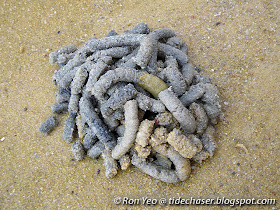The hemichordates (phylum hemichordata) are worm-like animals characterised by a three-part body - the front end (the prosome), followed by a collar (the mesome) and a posterior trunk (metasome). There is a flexible, hollow tube (the stomochord) in the collar region, somewhat resembling the notochord found in chordates (animals with a spinal cord at least in part of their life cycles). In fact, "hemi" means "half" in Greek, while "chorda" means "chord" in Latin.
Hemichordates share many similarities with the chordates. For example, they have a circulatory system with a heart, and also gill-like structures similar to the gills of primitive fish. Studies, however, suggest that hemichordates are most closely related to the echinoderms, and this is further supporter by the fact that the larvae of some hemichordates appear very similar to those of some echinoderms.
The only group of hemichordates recorded from Singapore so far is the acorn worms (class Enteropneusta). The other valid class of extant hemichordates, class Graptolithoidea, were colonial animals with tentacles for filter feeding, i.e. they filter plankton and other tiny organic particles in the water.
Acorn worms are solitary worm-like animals that live in U-shaped burrows. While some species are filter-feeders, most of them are deposit feeders - they swallow sand or mud and digest the tiny organic particles inside. During low tide, they will stick out their back end, and excrete the processed sediment in coils (called cast).

In fact, the acorn worms themselves are hardly seen, and most of the time, only the casts left behind during low tide are seen. The cast, however, is very similar to the casts deposited by lug worms. It is often difficult to tell them apart just by looking at the casts without digging out the animal, and hence, the photo above could be the cast of either one.
Acorn worms have separate sexes, though some species are also able to reproduce asexually. The females lay eggs embedded in mucus, and the males will release the sperm over them, fertilising them externally. Depending on the species, the eggs may hatch into planktonic larvae, miniature adults or an intermediate free-swimming form.
References
Hemichordates share many similarities with the chordates. For example, they have a circulatory system with a heart, and also gill-like structures similar to the gills of primitive fish. Studies, however, suggest that hemichordates are most closely related to the echinoderms, and this is further supporter by the fact that the larvae of some hemichordates appear very similar to those of some echinoderms.
The only group of hemichordates recorded from Singapore so far is the acorn worms (class Enteropneusta). The other valid class of extant hemichordates, class Graptolithoidea, were colonial animals with tentacles for filter feeding, i.e. they filter plankton and other tiny organic particles in the water.
Acorn worms are solitary worm-like animals that live in U-shaped burrows. While some species are filter-feeders, most of them are deposit feeders - they swallow sand or mud and digest the tiny organic particles inside. During low tide, they will stick out their back end, and excrete the processed sediment in coils (called cast).

In fact, the acorn worms themselves are hardly seen, and most of the time, only the casts left behind during low tide are seen. The cast, however, is very similar to the casts deposited by lug worms. It is often difficult to tell them apart just by looking at the casts without digging out the animal, and hence, the photo above could be the cast of either one.
Acorn worms have separate sexes, though some species are also able to reproduce asexually. The females lay eggs embedded in mucus, and the males will release the sperm over them, fertilising them externally. Depending on the species, the eggs may hatch into planktonic larvae, miniature adults or an intermediate free-swimming form.
References
- Cameron, C. B., J. R. Garey & B. J. Swalla. 2000. Evolution of the chordate body plan: new insights from phylogenetic analyses of deuterostome phyla. Proceedings of the National Academy of Sciences of the United States of America 97 (9): 4469–74.
- Ruppert, E.E. & R. D. Barnes. 1991. Invertebrate Zoology (International Edition). Saunders College Publishing. U.S.A. 1056 pp.
- Tan, L. W. H. & P. K. L. Ng. 1988. A Guide to Seashore Life. Singapore Science Centre. Singapore. 160 pp.
- World Register of Marine Species. 2012. Retrieved Feb 20, 2013, from http://www.marinespecies.org.

No comments:
Post a Comment